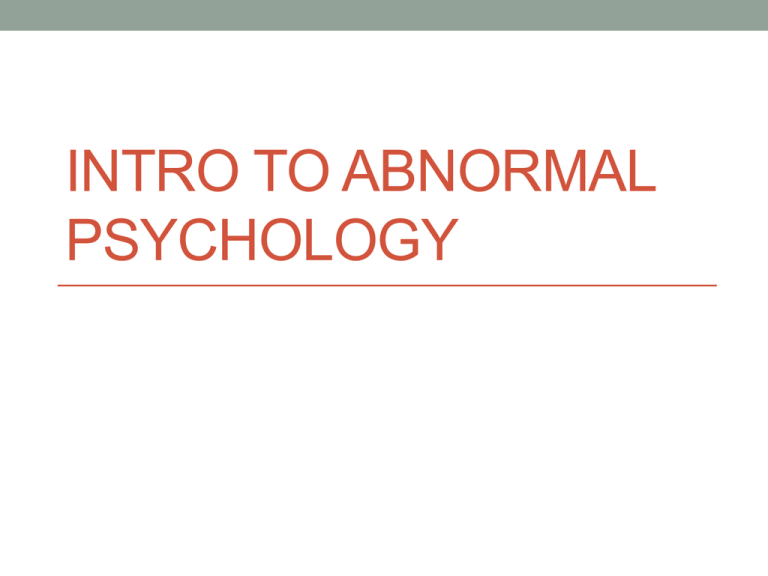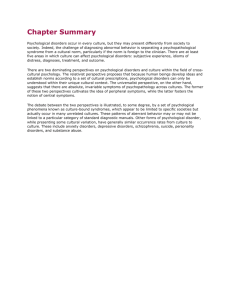Intro to Abnormal Psychology
advertisement

INTRO TO ABNORMAL PSYCHOLOGY Defining Psychological Disorders • Psychological Disorders: patterns of behaviors and/or cognition that fit the three Ds (deviant, distressful, dysfunctional): • Deviant: out of the ordinary. This one is slippery at best. • Context is the key- what is normal in one culture or situation is not in another. • Calling your boss out on a mistake in a U.S. business, rather than in Japan • Having a child out of wedlock in Victorian Britain Defining Psychological Disorders • (The Ds cont.) • Distressful: cause the individual concern, suffering, stress • Sometimes the individual is not distressed themselves • …and maybe they “should” be • Dysfunctional: the disorder in some way impairs or negatively alters our life • An acute fear of airplanes keeping you from visiting your grandchildren in Seattle Defining Psychological Disorders • Deviant behaviors that aren’t distressful and dysfunctional wouldn’t be considered a disorder • Einstein’s wardrobe of identical outfits is deviant (out-of-theordinary) • • But actually caused him less distress and allowed him to function even more. Would we consider the behaviors of Doc Brown from “Back to the Future” to qualify as a disorder (according to the three Ds)? Understanding Psychological Disorders • The historical approaches: • Devils, demons, exorcisms, chains, leeches, etc. • Be thankful you live in the “modern” era. Understanding Psychological Disorders • Medical Model: Disorders are like diseases, they can be diagnosed, treated, and hopefully cured. • Treatment may occur in a hospital/medical facility (but not always) • Just because it is the medical model does not mean that treatment/therapy is limited to “medical” methods (drugs, surgery, etc.) Understanding Psychological Disorders • The bio-psycho-social approach emphasizes the role that external and internal forces play in determining behavior • Some disorders appear to only impact certain societies • Latah: hyper sensitivity to fear, automatically repeating others’ words/emotions (isolated to Malaysian and Indonesian cultures) • Windigo Psychosis: acute anxiety about one’s being taken over by a monster and turned into a cannibal (Native Americans in Central and Northeastern Canada) • Source: http://faculty.valpo.edu/jnelson/.htm (much abliged, Prof. Nelson!) Classifying Psych Disorders • Over time, psychologists have attempted to give labels to certain behavior/cognition patterns • Then those labels are grouped with other labels into various types of disorders • The DSM V is the go-to book in the U.S. for classifying and diagnosing disorders. • Put out by the APA. Classifying Psych Disorders • For each disorder, key symptoms are described • But does not attempt to explain why symptoms arise • That’s for psychologists of differing perspectives to debate! • The DSM also has guidelines for diagnosing disorders • (based on questionnaires, interviews, and other studies) • Theoretically, by standardizing diagnosis methods, the DSM can increase reliability of diagnoses. Classifying Psych Disorders • Many feel the DSM has gone overboard • 60 disorders in the first edition, 400 presently. • Some are added, some taken away, some split. • Ex. Homosexuality has been out since 1973 • This raises the question: what current psych disorders will no longer be labeled as such 40 years from now? • Inclusion/Exclusion from the DSM changes because of shifting norms of what is deviant or dysfunctional Problems with Labels • The labels are also stigmas themselves • A patient may experience lower self-esteem from being diagnosed with one • Patient may use that as an excuse for negative behavior that they may in fact be able to control • The social stigma of disorder labels make it more difficult for patients to experience more normal relationships with others. • We tend to look down on those with disorders • Shifts in pop-culture & even the actual names of the disorders themselves suggest a shift away (in part) from these social stigmas






